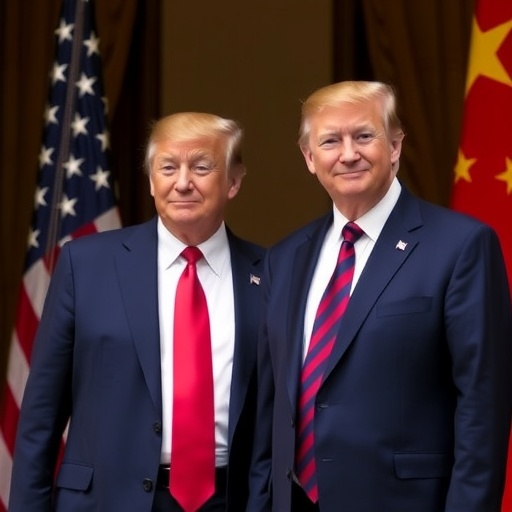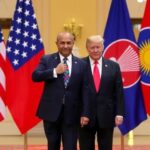Donald Trump Signals Breakthrough in US-China Trade Talks During Asia Tour, Prioritizing Fentanyl Crackdown and Agricultural Exports
In a bold move that could reshape global economic dynamics, President Donald Trump has voiced strong optimism about securing a comprehensive trade deal with China while on his high-profile Asia tour. Speaking to reporters in Tokyo on the first leg of the trip, Trump emphasized that negotiations would tackle longstanding issues like fentanyl trafficking and boosting American agricultural exports, signaling a potential thaw in US-China trade tensions that have simmered for years.
- Trump’s Tokyo Stop Sets Tone for Ambitious US-China Trade Push
- Fentanyl Flood: How the Opioid Crisis Fuels US Demands in Trade Negotiations
- Agricultural Exports Revival: Midwestern Farmers Pin Hopes on Asia Tour Deal
- Beijing Showdown: Navigating Hurdles in the Quest for US-China Trade Harmony
- Global Ripples: What a US-China Trade Breakthrough Means for the World Economy
The announcement comes at a pivotal moment, as the US grapples with a deadly opioid crisis fueled by fentanyl precursors sourced from China, and Midwestern farmers seek relief from retaliatory tariffs that have slashed soybean sales. Trump’s Asia tour, spanning Japan, South Korea, Vietnam, and culminating in China, is poised to be a diplomatic whirlwind, with trade at the forefront. “We’re going to make a deal that’s fair for American workers,” Trump declared, his words echoing the protectionist rhetoric that defined his 2016 campaign.
According to White House officials, the tour builds on preliminary talks held in Washington last month, where US negotiators outlined demands for stricter controls on fentanyl shipments and tariff reductions on US farm goods. Economists estimate that a successful agreement could inject billions into the US economy, particularly in rural states hit hard by trade wars. But with Beijing’s own economic slowdown and geopolitical frictions, the path to a deal remains fraught with obstacles.
Trump’s Tokyo Stop Sets Tone for Ambitious US-China Trade Push
President Donald Trump‘s Asia tour kicked off in Tokyo with a clear message: the US is ready to engage China on equal terms in US-China trade matters. Meeting with Japanese Prime Minister Shinzo Abe, Trump highlighted the alliance’s role in countering Chinese economic influence in the region. “Japan understands the importance of fair trade, and together we’ll pressure China to open its markets,” Trump said during a joint press conference, flanked by American flags and cherry blossom backdrops.
The Tokyo leg of the Asia tour wasn’t just ceremonial; it included substantive discussions on supply chain diversification away from China, a strategy aimed at reducing US dependence on Chinese manufacturing. US Trade Representative Robert Lighthizer, accompanying Trump, revealed that preliminary data shows Japanese investments in US tech sectors have surged 25% since the start of trade tensions, per a recent Commerce Department report. This sets a collaborative tone as Trump heads to Beijing, where the real stakes in US-China trade lie.
Historical context underscores the urgency. The US-China trade deficit ballooned to $419 billion in 2018, prompting Trump’s initial tariffs on $300 billion worth of Chinese goods. Agricultural exports, once a bright spot in bilateral ties, plummeted by 74% for soybeans alone after China’s retaliatory measures. Trump’s tour aims to reverse this, with promises of “phase two” negotiations that go beyond the 2020 Phase One deal, which fell short on enforcement.
Experts like Gordon Chang, author of “The Coming Collapse of China,” praised the approach in an interview with CNN. “Trump’s personal diplomacy could unlock doors that bureaucrats can’t,” Chang noted, adding that the Asia tour’s multi-stop format allows for building coalitions among US allies to amplify pressure on Beijing.
Fentanyl Flood: How the Opioid Crisis Fuels US Demands in Trade Negotiations
At the heart of Trump’s push for a comprehensive US-China trade deal is the fentanyl crisis, a public health emergency that has claimed over 100,000 American lives annually, according to CDC data. The synthetic opioid, often mixed with heroin or pressed into counterfeit pills, traces its chemical precursors back to clandestine labs in China, making it a flashpoint in bilateral relations.
During his Asia tour, Trump reiterated that curbing fentanyl trafficking is non-negotiable. “China must shut down these factories pouring poison into our communities,” he stated in Seoul, the tour’s second stop, where he met with South Korean President Moon Jae-in. US Customs and Border Protection seized over 26,000 pounds of fentanyl in fiscal year 2022, with a significant portion linked to Chinese suppliers, highlighting the scale of the issue.
The administration’s strategy ties fentanyl controls directly to trade concessions. In exchange for enhanced regulatory oversight and extradition of key traffickers, the US is offering to ease restrictions on Chinese tech imports. This linkage has precedent; the Phase One deal included commitments from China to criminalize fentanyl exports, but enforcement has been spotty, with only a handful of prosecutions reported.
Dr. Nora Volkow, director of the National Institute on Drug Abuse, emphasized the human cost in a recent op-ed for The New York Times. “Fentanyl isn’t just a trade issue; it’s killing our families. A strong US-China trade agreement could save lives by dismantling supply chains.” Advocacy groups like Families Against Fentanyl have mobilized, urging Trump to leverage the Asia tour for ironclad promises from Xi Jinping.
Statistics paint a grim picture: Over 70% of US fentanyl seizures originate from China via mail carriers or Mexico-based cartels. Trump’s negotiators are pushing for real-time data sharing and joint task forces, potentially modeled after the US-Mexico Merida Initiative. If successful, this could reduce overdose deaths by 20-30%, per projections from the RAND Corporation.
Agricultural Exports Revival: Midwestern Farmers Pin Hopes on Asia Tour Deal
For American farmers battered by years of US-China trade volatility, Trump’s Asia tour represents a lifeline for agricultural exports. Soybeans, corn, and pork—staples of US agriculture—saw exports to China drop from $24 billion in 2017 to under $10 billion by 2019, forcing many family farms into bankruptcy, according to USDA figures.
In Hanoi, Vietnam, during the tour’s third leg, Trump touted potential market access gains. “We’re bringing back billions for our farmers,” he promised, referencing Vietnam’s growing role as a US trade partner amid diversification efforts. The US-China trade framework under discussion includes tariff eliminations on key ag products, which could restore pre-trade war levels within two years.
The National Farmers Union estimates that a comprehensive deal could add $15 billion annually to agricultural exports, benefiting states like Iowa and Illinois. Quotes from farmers underscore the stakes: “We’ve been hanging on by a thread,” said Iowa soybean grower Tom Vilsack in an NPR interview. “Trump’s trip could be the reset we need.”
Contextually, China’s demand for US ag goods is rebounding due to domestic supply shortages from weather events and the COVID-19 aftermath. Beijing imported 100 million tons of soybeans in 2022, up 10% from the prior year, creating an opportunity. However, challenges persist; Chinese state media has criticized US demands as “protectionist,” signaling tough bargaining ahead.
To bolster the case, Trump’s team is highlighting sustainability angles, promoting US crops as environmentally superior. A recent EPA report notes that American farming practices reduce methane emissions by 15% compared to Asian counterparts, appealing to China’s green pledges under the Paris Agreement.
Beijing Showdown: Navigating Hurdles in the Quest for US-China Trade Harmony
As President Donald Trump’s Asia tour reaches its climax in Beijing, the spotlight intensifies on forging a comprehensive US-China trade pact. Arriving amid tight security, Trump is set to hold summit-level talks with President Xi Jinping, focusing on mutual concessions that address intellectual property theft, market access, and the aforementioned priorities of fentanyl and agricultural exports.
Optimism tempers realism; while Trump predicts a “historic” agreement, analysts point to deep-seated issues. The US International Trade Commission reports that Chinese subsidies to state-owned enterprises distort $100 billion in annual trade flows, a grievance likely to surface. Quotes from Treasury Secretary Steven Mnuchin, traveling with the delegation, suggest flexibility: “We’re open to innovative solutions that benefit both economies.”
The tour’s broader Asia context amplifies leverage. Stops in Japan and South Korea have secured side deals on 5G infrastructure, reducing reliance on Huawei and pressuring China indirectly. In Vietnam, Trump announced a $2 billion aid package for regional trade infrastructure, further diversifying supply chains.
Public sentiment in the US is mixed; a Pew Research poll shows 60% of Americans view US-China trade as a top concern, with fentanyl cited by 45% as the biggest threat. Beijing’s response has been measured, with state outlets like Xinhua expressing willingness to “cooperate on global challenges.” Yet, underlying tensions— from Taiwan Strait maneuvers to tech bans—could derail progress.
Stakeholders from Wall Street to Silicon Valley are watching closely. Goldman Sachs forecasts that a deal could lift US GDP by 0.5% in 2024, while tech firms like Apple seek clarity on tariffs affecting iPhone assembly.
Global Ripples: What a US-China Trade Breakthrough Means for the World Economy
A successful outcome from Trump’s Asia tour could cascade into profound global implications, stabilizing supply chains disrupted by years of US-China trade friction. With world trade volumes projected to grow 3.5% in 2023 per the WTO, a comprehensive deal would accelerate this, particularly in agriculture and pharmaceuticals.
For fentanyl, enhanced cooperation might extend to international forums like the UN, curbing flows to Europe and Australia, where overdose rates are rising 20% yearly. On agricultural exports, restored US access to China could lower global food prices, benefiting developing nations in Africa and Latin America reliant on commodity imports.
Looking ahead, the agreement’s enforcement mechanisms—potentially including WTO arbitration—will be crucial. Trump’s team envisions annual reviews, with snap-back tariffs for non-compliance. Economists at the Brookings Institution predict that if realized, this could foster a new era of multilateral trade, drawing in allies like the EU, which faces its own $200 billion deficit with China.
Challenges remain, including domestic politics; Trump’s opponents in Congress may demand bipartisan oversight. Yet, the momentum from the Asia tour suggests a pivotal shift. As negotiations unfold, the world watches whether Donald Trump’s deal-making prowess can bridge the US-China trade divide, paving the way for shared prosperity amid geopolitical storms.








